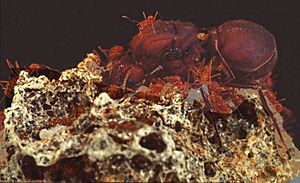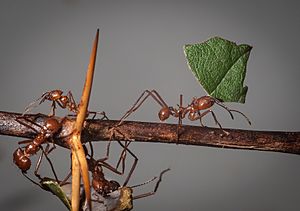Atta (ant) facts for kids
Quick facts for kids Atta (ant) |
|
|---|---|
 |
|
| Queen of A. colombica | |
| Scientific classification |
|
| Kingdom: | Animalia |
| Phylum: | Arthropoda |
| Class: | Insecta |
| Order: | Hymenoptera |
| Family: | Formicidae |
| Subfamily: | Myrmicinae |
| Tribe: | Attini |
| Genus: | Atta Fabricius, 1805 |
| Type species | |
| Atta cephalotes Linnaeus, 1758
|
|
| Diversity | |
| 17 species | |
| Synonyms | |
|
|
Atta is a group of ants found in the New World (North, Central, and South America). These ants are famous for being "leafcutters." There are at least 17 known species in this group.
Atta leafcutter ants are quite large. They are usually rusty red or brown. They have spiny bodies and long legs. Inside their nests, there are three main types of ants: the queen, workers, and soldiers. Only the queens and males have wings. These winged ants are also called "reproductives" because they are the ones that start new colonies. Most ants in a nest are female, but only the queens lay eggs. Queens are usually over 20 millimeters long.
Contents
What Are Atta Ants?
Atta ants are a type of leafcutter ant. They are one of two main groups of leafcutter ants, the other being Acromyrmex. Atta ants do not sting, so they don't inject venom. However, they are known for their strong bites!
These ants show a high level of polymorphism. This means that ants in the same colony can look very different and have different jobs. In an established colony, there are four main types, or "castes":
- Minims: These are the smallest ants. They often work inside the nest.
- Minors: Slightly larger than minims, they also do various tasks.
- Mediae: These are medium-sized workers. They are often seen cutting leaves.
- Majors: These are the largest ants, also called soldiers. They protect the colony.
All young ants go through four larval stages as they grow. Even as larvae, they are connected to the special fungus they eat.
The different sizes and jobs of Atta ants show how advanced they are. Each type of ant has a specific role. For example, the tiny minim ants often ride on the leaf pieces that media workers carry back to the nest. They do this to protect the media workers from a type of fly that tries to lay eggs on them. While riding, the minims also help clean the leaf pieces before they enter the nest. They also drink the sap from the leaves. This "hitchhiking" behavior shows how specialized these ants are.
Just like Acromyrmex ants, Atta ants mostly eat a special type of fungus. They grow this fungus themselves on a bed of chewed-up leaf pieces. This fungus is the only food for the queen and other ants that stay inside the nest. The media workers also get food by drinking plant sap while they cut leaves.
When a new queen leaves her parent colony, she carries a small piece of this fungus with her. She uses this piece to start a new fungus garden in her new nest. At first, the queen doesn't eat the fungus. She lets it grow by fertilizing it with her waste. She survives by using her own body fat and by eating about 90% of the eggs she lays. She also breaks down her wing muscles for energy.
Atta ants have learned to switch between different types of plants for food. This stops them from completely stripping all the leaves from one tree, which would kill it. This way, they avoid running out of food. However, they still harvest huge amounts of leaves. It's thought that Atta ants are responsible for breaking down 20% of all leaves in South America. Because of this, they are considered a big agricultural pest in areas where they live near farms.
How Atta Ants Evolved
Leafcutter ants, including Atta and Acromyrmex, are unique because they grow fungus underground. These two groups of ants split from a common ancestor about 10 million years ago. Their closest relatives are the Trachymyrmex and Sericomyrmex groups, which split off about 17 million years ago.
Leafcutter ants are very specialized. They developed a close relationship with fungus over millions of years, starting about 50 million years ago. This is called coevolution. Over time, the fungus lost its ability to produce spores on its own. The ants then started relying on the fungus as their main food source. About 66 million years ago, South America became separated from other landmasses. This is when these "gardening ants" began their relationship with the fungus. It's believed that leafcutter ants have helped the same type of fungus reproduce for 25 million years.
Atta Ants and Their Environment
Leafcutter ants can create open spaces in forests by building their large nests. They dig up soil that is rich in organic matter. They also store extra organic matter in their underground chambers. This creates rich soil that helps plants grow.
The ants also trim the leaves of smaller plants under the main forest canopy. This allows more sunlight to reach the forest floor. They can also influence the types of trees and plants that grow by carrying seeds into their underground chambers. Depending on where the chamber is, a seed might get enough light to grow.
Species
- Atta bisphaerica Forel, 1908
- Atta capiguara Gonçalves, 1944
- Atta cephalotes (Linnaeus, 1758)
- Atta colombica Guérin-Méneville, 1844
- Atta cubana Fontenla Rizo, 1995
- Atta goiana Gonçalves, 1942
- Atta insularis Guérin-Méneville, 1844
- Atta laevigata (F. Smith, 1858) (Colombia south to Paraguay)
- Atta mexicana (Smith, 1858)
- Atta opaciceps Borgmeier, 1939
- Atta pilosa (Buckley, 1866)
- Atta robusta Borgmeier, 1939
- Atta saltensis Forel, 1913
- Atta sexdens (Linnaeus, 1758)
- Atta tardigrada (Buckley, 1866)
- Atta texana (Buckley, 1860) - Texas leafcutter ant (East Texas and western Louisiana in the United States, northeastern Mexico)
- Atta vollenweideri Forel, 1893
Atta Ants as Food

Atta ants are a popular food in Mexican cuisine, especially in southern states like Chiapas and Oaxaca. They are considered a special treat and are high in protein. They are often served as a main dish, not just a small side. You can even find them as the only filling in tacos. Atta ants, which are the most common type eaten in Mexico, have a nutty flavor.
In Brazil, the queens of leafcutter ants (called tanajuras there) are also enjoyed as a delicacy in many areas. The ways people catch and cook them are considered an important part of the culture in the town of Tianguá, in Ceará.
Atta ants are also eaten by the Guanes tribe.
See also
 In Spanish: Atta para niños
In Spanish: Atta para niños



